Chickens come in many varieties and colors. When choosing the right breed, you should consider the number of eggs and meat quality. Other than that, you might want to add striking-colored chickens like yellow-colored ones in your flock. Please take a look down below as I categorize them for you.
1. Buff Brahma

| Feature | Details |
| Purpose | Dual-purpose |
| Egg Color | Brown |
| Egg Size | Medium to Large |
| Broodiness | Usually Broody |
| Heat Tolerance | Yes |
| Cold Tolerance | Yes |
| Comb Type | Pea Comb |
| Egg Production | About 150 to 200 eggs per year |
| Chicken Skin Color | Yellow |
| Life Span | 5-8 years |
| Adult Weight | Hen: 6-10 lbs, Rooster: 9-12 lbs |
| Backyard Friendly | 4/5 |
Buff Brahma is not only eye-catching but these chicken breeds can be considered as the king of chickens. This is because Buff Brahma is a giant chicken breed. They are a great addition to your coop since they require low maintenance.
You will not have a problem keeping Buff Brahma with another breed since they can quickly get along with others. These chickens can be considered good pets since they are gentle and docile. These chickens can lay a good amount of large brown eggs.
Rooster Brahmas are large and can weigh about 12 pounds, while hens weigh about 10 pounds. Regarding their height, Brahmas typically average between 8 to 18 inches, with some reaching a maximum of thirty inches tall. There are Bantam Buff Brahmas, but they are rare to find; their height can be about 4 inches tall.
Buff Brahma like to be in a free-range area to look for food; they like foraging. They can get a substantial portion of their nutritional needs and requirements when free to forage in a free-range area.
These chickens are heavy feeders; letting them feed in a free-range area will benefit them and keep you from the feeding costs. Brahmas have thick and dense feathers. Hence, they are unsuitable for southern climates because they may suffer from excessive heat when the temperature rises, and these chickens may experience heat stress.
Brahmas are friendly and easy to tame; they are best suited for homesteads with adequate space. However, their sizes can be intimidating to children. They lay a moderate amount of eggs. Hens can lay three large brown eggs per week; to sum up, they can lay 150 large brown eggs yearly.
2. Buff Rock
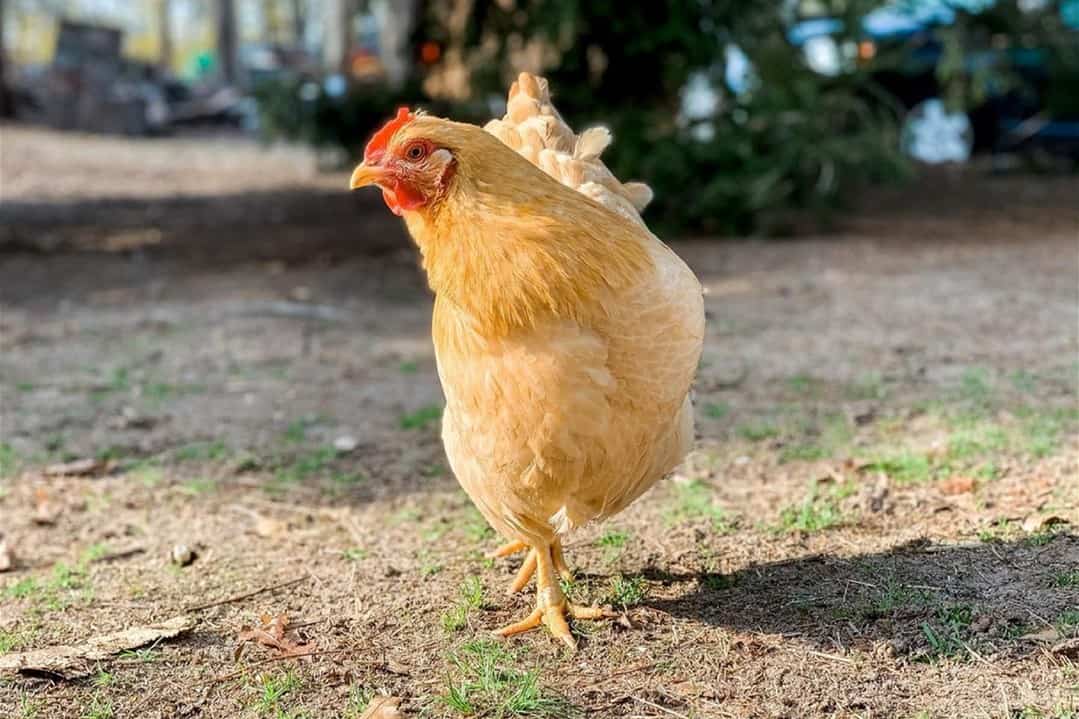
| Feature | Details |
| Purpose | Dual-purpose |
| Egg Color | Brown |
| Egg Size | Medium to Large |
| Broodiness | Usually Broody |
| Heat Tolerance | Yes |
| Cold Tolerance | Yes |
| Comb Type | Single Comb |
| Egg Production | About 200 to 280 eggs per year |
| Chicken Skin Color | Yellow |
| Life Span | 10-12 years |
| Adult Weight | Hen: 7-8 lbs, Rooster: 9-10 lbs |
| Backyard Friendly | 4/5 |
Buff Rock is famous among farm chicken breeds. Buff rock chickens are considered gorgeous yellow chickens due to their yellow-colored legs, beaks, and feathers. It’s red wattles and red combs add to the overall beauty of the Buff Rock. They don’t have feathers on their legs and feet. Buff Rock is single-combed, and it can tolerate cold and hot temperatures.
These chickens are beautiful; they are also good egg layers and an excellent source of meat due to their size. They are good at laying eggs since they can lay about 200 eggs annually. They are a great source of meat since they are very broody. The eggs of Buff Rock are light brown. They usually weigh about 7 to 9 and a half pounds. They are best to be kept on the farm due to their excellent laying capabilities and meat quality.
3. Black-Tailed Buff Japanese
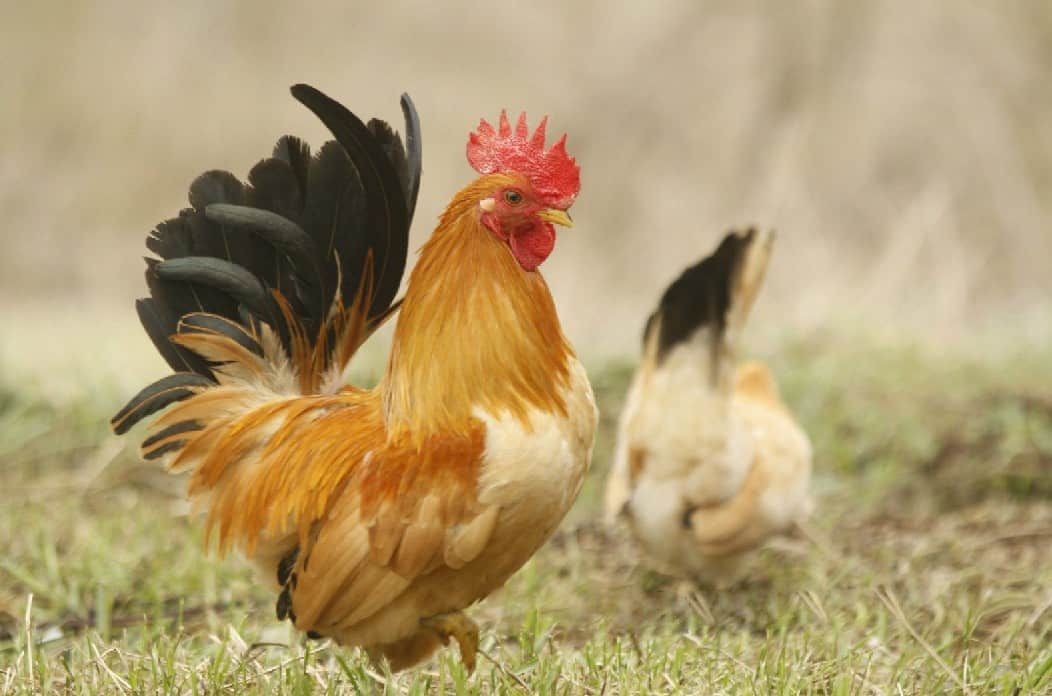
| Feature | Details |
| Purpose | Ornamental |
| Egg Color | White |
| Egg Size | Small |
| Broodiness | Broody |
| Heat Tolerance | Yes |
| Cold Tolerance | No |
| Comb Type | Single Comb |
| Egg Production | About 60 to 120 eggs per year |
| Chicken Skin Color | Yellow (commonly but may vary) |
| Life Span | 8-13 years |
| Adult Weight | Hen: 22-26 oz, Rooster: 26-30 0z |
| Backyard Friendly | 3/5 |
Black-Tailed Buff Japanese chicken originates in Japan and is known for its yellow feathers and a black tail. They are small in size with arched tail feathers and short legs. They are considered bantam due to their sizes.
They are single-combed with short shanks and large tails. Cocks may weigh from 510 to 600 grams, while the hen may weigh from 400 to five hundred ten grams. Though hens may be easy to tame, some roosters may be aggressive sometimes.
These chickens are unique, generally well-behaved, and easy to tame. They are good foragers in warm, dry weather. They are not good layers of eggs and fairly lay small amounts of eggs for approximately 60 pieces per year.
heir hatching rates are lower due to lethal gene combinations, which causes 25% of the eggs to be unable to hatch. They are unlikely to be kept in cold areas since they have large combs and may suffer from frostbite.
However, they might be kept in a tight and warm coop during winter, provided with supplemental heat that they need. They can be good pets and are long-lived since their lifespan is up to 13 years, provided with proper care.
4. Buff Silkies

| Feature | Details |
| Purpose | Ornamental |
| Egg Color | White or Tinted Cream |
| Egg Size | Small to Medium |
| Broodiness | Usually Broody |
| Heat Tolerance | No |
| Cold Tolerance | Yes |
| Comb Type | Walnut-shaped Comb |
| Egg Production | About 100 to 150 eggs per year |
| Chicken Skin Color | Blue-black, Dark |
| Life Span | 5-8 years |
| Adult Weight | Hen: 32-36 oz, Rooster: 36-40 oz |
| Backyard Friendly | 3/5 |
One of the unique chickens on the list is the Buff Silkie. They are known for their fluffy plumage and are one of the breeds of chicken with five toes. These chickens are not only uncommon but also adorable since they are calm, sweet, and gentle.
These breeds’ most common color variety is black and white, but they also come in beautiful golden buff colors. Silkie belongs to the Bantam family and can weigh only one to three pounds.
These chickens are broody, and they are unlikely to lay more eggs. Some are discouraged from taking care of these breeds since they have lower hatching rates. Though they may hatch, their eggs are small, usually white or brownish.
Nonetheless, they are very gentle and loving mothers since they take care of their chicks and chicks from other eggs and even duck eggs. Buff Silkies cannot fly due to their silkie hairlike feathers, and they can be family pets since they are friendly and docile.
5. Buff Laced Wyandotte
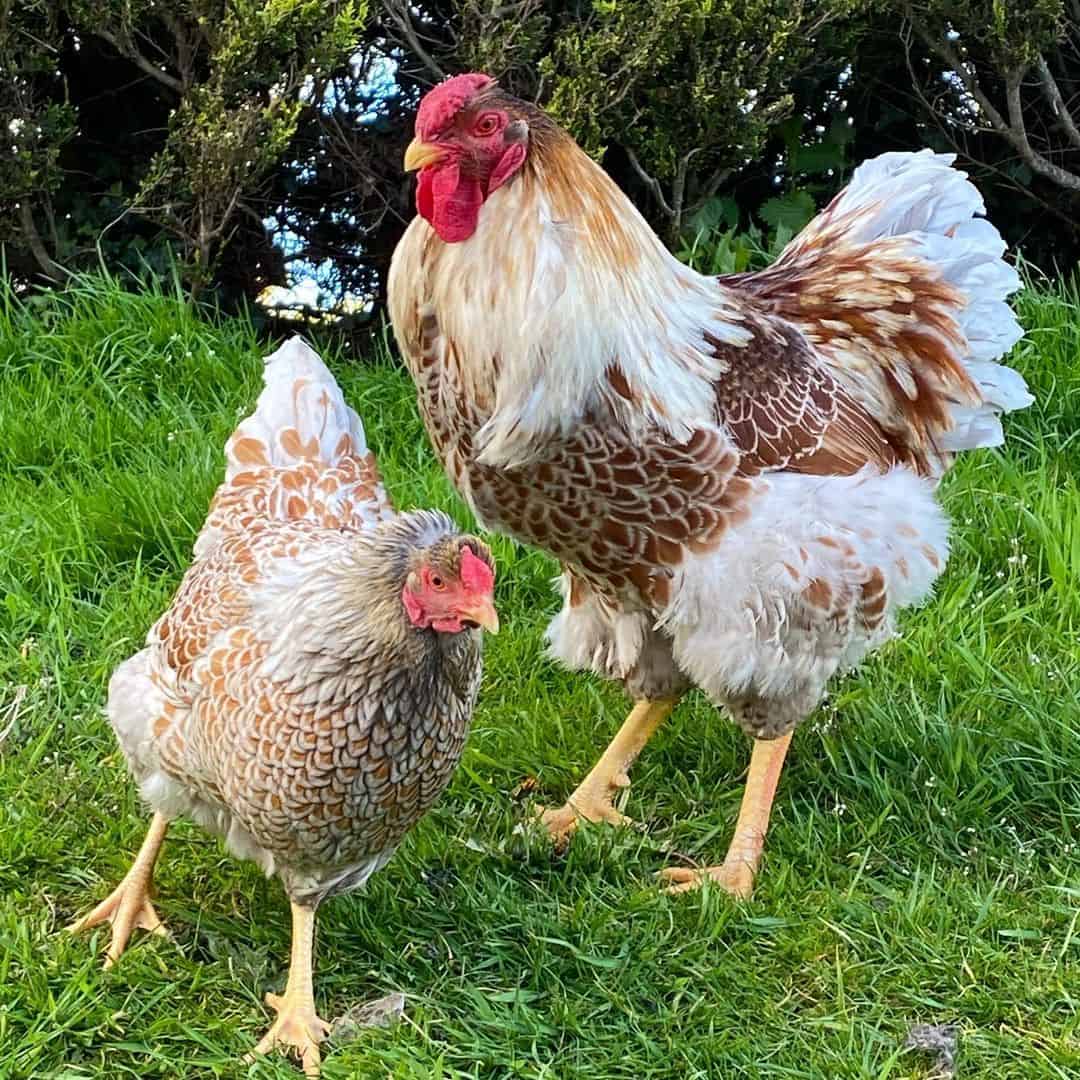
| Feature | Details |
| Purpose | Dual-purpose |
| Egg Color | Brown |
| Egg Size | Medium to Large |
| Broodiness | Moderately Broody |
| Heat Tolerance | Moderate |
| Cold Tolerance | Yes |
| Comb Type | Rose Comb |
| Egg Production | About 200 to 250 eggs per year |
| Chicken Skin Color | Yellow |
| Life Span | 5-8 years |
| Adult Weight | Hen: 6-7 lbs, Rooster: 7-8 lbs |
| Backyard Friendly | 5/5 |
Buff Laced Wyandotte chicken is originally an American breed; these chickens are named after a Native American tribe called “Wendat.” This chicken breed has a classic round shape with glamorous and laced feathers.
They have traditional yellow legs and feet, while their wattles and combs have a deep glorious red color. They have a small and heart-shaped comb which makes this chicken less to have frostbite.
Buff Laced Chickens are large breeds; males weigh approximately eight and a half pounds, while females weigh about six pounds. This breed also comes with varieties of bantams that weigh about three pounds to three and three-fourths pounds.
Wyadonettes has a powerful personality but is generally friendly and calm. They most like to create noises, and most breeders tend to annoy these characters. If you plan to get one, it would be best to allow them to forage in a free-range area.
Hens are good egg layers since they can produce about 200 eggs per year. The color of the eggs is white to light creamy brown color. Their strong and loosely packed feathers make them withstand cold weather.
6. Buff Laced Polish

| Feature | Details |
| Purpose | Ornamental |
| Egg Color | White |
| Egg Size | Small to Medium |
| Broodiness | Not Broody |
| Heat Tolerance | Yes |
| Cold Tolerance | Yes |
| Comb Type | V-shaped Comb |
| Egg Production | About 100 to 150 eggs per year |
| Chicken Skin Color | Yellow |
| Life Span | 8-9 years |
| Adult Weight | Hen: 3-4 lbs, Rooster: 4-5 lbs |
| Backyard Friendly | 4/5 |
Buff Laced Polish is a rare breed of chicken from the European breed and is known for its distinctive crest. Though you may think that it came from Poland, it originally came from Germany and the Netherlands. It is named Polish because its crest resembles the headgear that the Polish Army once used.
These chickens are gentle and docile; however, they are easily startled because of their limited vision. The crest of Buff Laced Polish makes them see less. These chickens have stunning features due to their rich golden buff laced with creamy white feathers, and their shanks and toes have a dainty slate color.
Buff Laced Polish chicken comes in two varieties, the bearded and the non-bearded. These chicken breeds are usually kept as egg hatchers but sometimes ornamental. They lay a moderate amount of eggs, about 100 to 150 white eggs per year.
Buff Laced Polish has a similar body structure to the Leghorn, but they differ from the skull structure, giving the Polish a crest. The standard weight for the rooster is around 6 pounds; the hens weigh about four and a half pounds, the cockerel weighs about 5 pounds, and the pullet weighs about 4 pounds.
7. Buff Easter Egger

| Information | Detail |
| Purpose | Egg-Laying |
| Egg color | Blue
Green Pinkish |
| Egg size | Medium to Large |
| Egg production per year | Around 200 to 280 |
| Broody | Yes |
| Heat tolerance | Yes |
| Cold tolerance | Yes |
| Comb type | Pea
Single |
| Chicken skin color | Yellow |
| Life span | 6-8 years |
| Adult weight (hen) | 4-6 lbs |
| Adult weight (rooster) | 5-8 lbs |
| Backyard friendly | 5/5 |
Buff Easter Egger is a hybrid chicken. This breed is extremely popular because you never get to know the color of its eggs. It is called Easter Egger since they are likely to have colored shells. It is unique and exciting to have these types of chickens that lay colorful eggs.
Easter egger has a pea comb and wattle and is almost nonexistent. The color of their eyes can be reddish, yellow, or orange. Their legs may vary in color; sometimes, it ranges from yellow to greenish slate.
You may be having a hard time identifying which is a hen or which is a rooster. However, the best way to identify their gender is to observe their behaviors. Roosters are very curious and tend to roam around, while hens are quiet and cautious.
The weight of Easter Egger roosters can be around 5 pounds, while hens are about 4 pounds. There are also bantams, hens, and roosters. Easter Eggers may come in color variations.
They enjoy being active and will likely rummage around the yard. The oocyanin pigment makes the eggs pale blue colors, while the second pigment, called protoporphyrin, makes the eggs have green or olive color.
These breeds are known to be calm and nonaggressive. Easter Eggers are easy to tame; you can even feed them in your lap or your hands. Hens can lay four eggs per week and lay more than 200 eggs per year for egg production. Their eggs are medium in size, and their color may range from green, teal, pale blue, and pink. They like to be in a free-range area since they want to forage.
8. Single Comb Buff Leghorns
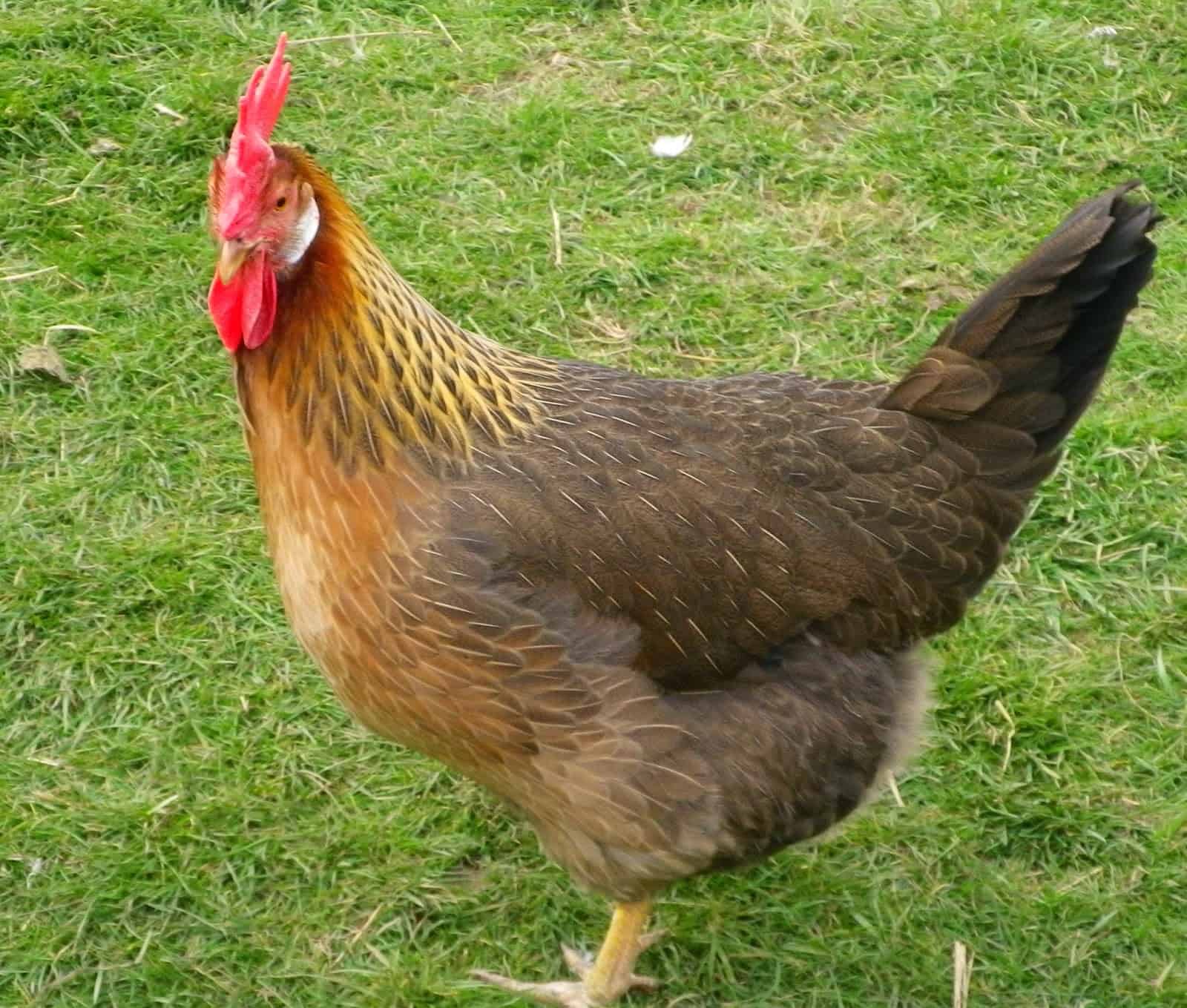
| Feature | Details |
| Purpose | Egg-laying |
| Egg Color | White |
| Egg Size | Large |
| Broodiness | Not Broody |
| Heat Tolerance | Yes |
| Cold Tolerance | No |
| Comb Type | Single Comb |
| Egg Production | About 280 to 320 eggs per year |
| Chicken Skin Color | Yellow |
| Life Span | 5-8 years |
| Adult Weight | Hen: 5-6 lbs, Rooster: 7-8.5 lbs |
| Backyard Friendly | 5/5 |
Single Comb Buff Leghorns are known to originate in Italy and are known to be outstanding egg layers. Hens can lay eggs for many years and lay eggs at a rate of four to six eggs per week. These chickens are not comfortable around strangers but will eventually be sweet once they feel comfortable.
Leghorns have big wattles and floppy combs, which can become a problem during the cold season since they are not cold tolerant. They have a slim and upright profile. Hens can weigh about five to six pounds, while roosters can weigh seven to eight and a half pounds. There are also bantam hens which weigh about 1.4 pounds, and the rooster weighs 1.7 pounds.
When it comes to egg production, Leghorns can lay four to six eggs per week. Though Leghorns may vary in color, they do have the same egg color, which is white. These chickens are nervous, flighty, noisy, and unlikely to care in urban areas.
Nonetheless, these chickens are adaptive to hot climates but struggle in the cold. They are light eaters, and you can save more in feed since they like to forage and roam around to look for food.
9. Buff Orpington
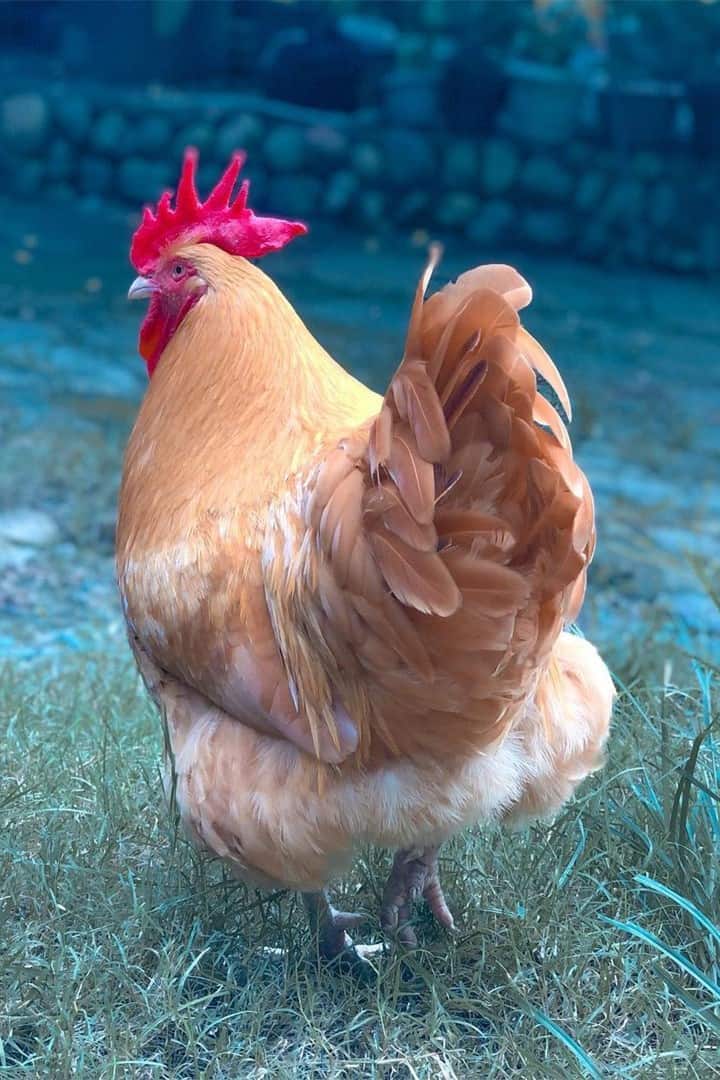
| Feature | Details |
| Purpose | Dual-purpose |
| Egg Color | Brown |
| Egg Size | Medium to Large |
| Broodiness | Usually Broody |
| Heat Tolerance | Yes |
| Cold Tolerance | Yes |
| Comb Type | Single Comb |
| Egg Production | About 175 to 250 eggs per year |
| Chicken Skin Color | Yellow |
| Life Span | 5-10 years |
| Adult Weight | Hen: 7 lbs, Rooster: 8 lbs |
| Backyard Friendly | 5/5 |
Buff Orpington is a British chicken breed and was bred in the 19th century by William Cook. The intention of William Cook to produce this chicken was for egg and meat production, but it soon became a show bird exclusively. In the 20th century, Herman Kuhn developed a bantam variety that comes in different colors. Bantams are friendly and less likely to fly, and sometimes never fly.
Orpington roosters weigh about 8 lbs, while hens weigh about 7 lbs. They have a heavy, broad body structure and curvy shape with a short back. These physical traits contribute to their suitability as a dual-purpose breed. Hens can lay about 175 to 250 eggs per year, ranging from medium to large.
Orpington are calm and steady breeds; they can be mostly seen strolling, looking for food. They like to be around humans and want to be picked up and pampered. They are less noisy, so they can be kept in urban areas since they can’t disturb your neighbors. Orpingtons can thrive in most environments, and you may not require much care.
10. Buff Cochin
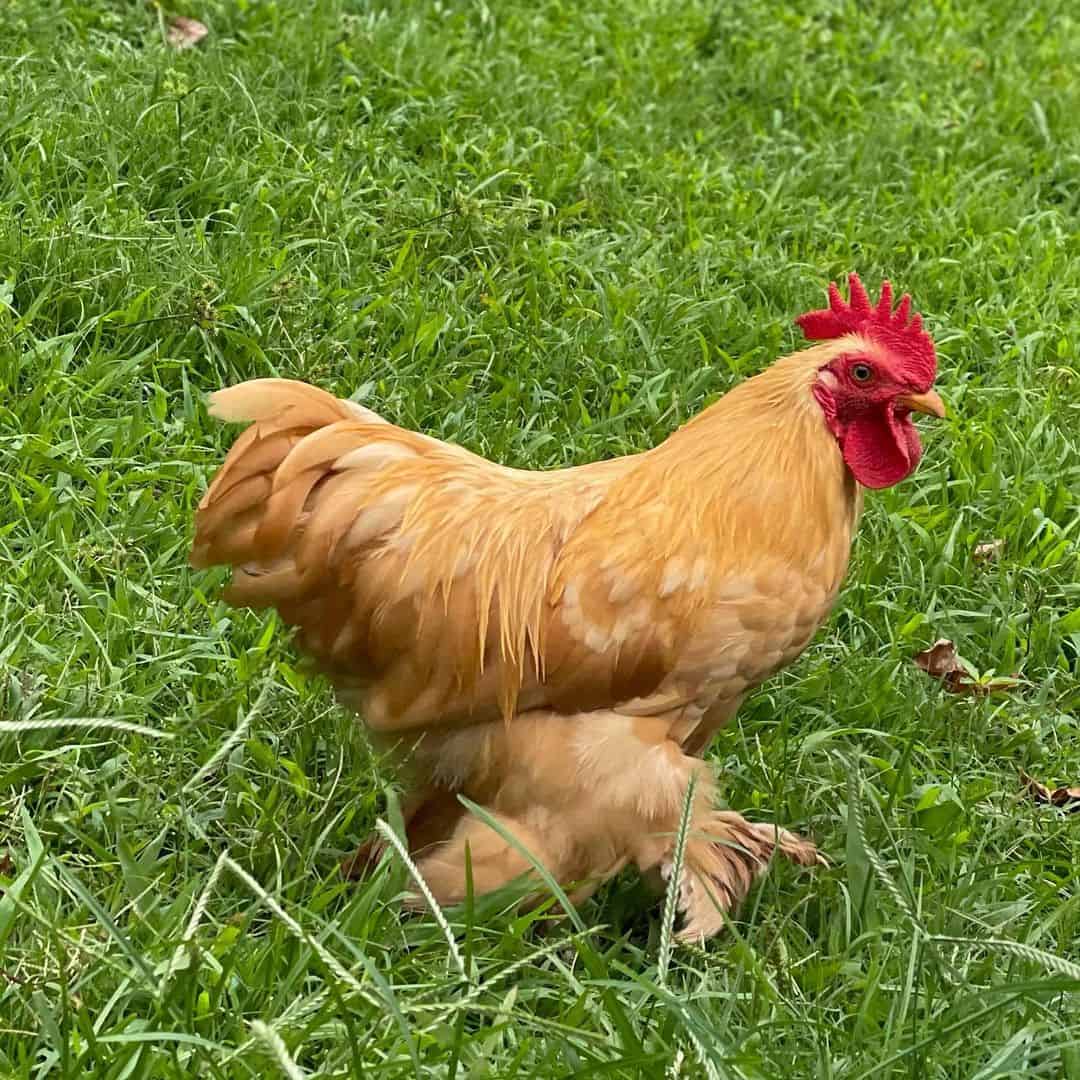
| Feature | Details |
| Purpose | Dual-purpose |
| Egg Color | Brown |
| Egg Size | Medium to Large |
| Broodiness | Usually Broody |
| Heat Tolerance | Yes |
| Cold Tolerance | No |
| Comb Type | Single Comb |
| Egg Production | About 140 to 156 eggs per year |
| Chicken Skin Color | Yellow |
| Life Span | 8-10 years |
| Adult Weight | Hen: 7-8.5 lbs, Rooster: 9-11 lbs |
| Backyard Friendly | 4/5 |
Buff Cochins are large domestic chickens that came from China and were brought to Europe and North America. There were first known as Shanghai birds and later called Cochin-Chinas. Their large sizes appealed to people’s interest in raising poultry breeding. Buff Cochin has both full-sized and bantam-sized varieties.
Cochin has a distinctive feature of excessive plumage that covers its legs and feet. Cochin is a yellow-skinned type of chicken. Cochins have a very productive characteristic that involves good egg-laying capacity.
They can lay about 2 to 3 medium eggs per week, amounting to about 104 to 156 eggs per year. It can lay tinted large eggs and can even lay well in winter. They are broody, and hens are good mothers and can even hatch turkey and duck eggs.
Cochin is a large breed of chicken, and hens can weigh about 7 to 8.5 pounds, while roosters can weigh 9 to 11 pounds. Cochins are a very laid-back and mellow type of chicken. They would rather stay in one place beside their feeder rather than roam around. Cochins can be a great pet and can be trained too.
11. Lemon Pyle Brahma

| Feature | Description |
| Purpose | Dual-purpose |
| Egg Color | Brown or Tinted |
| Egg Size | Large to Extra-large |
| Broodiness | Moderately Broody |
| Heat Tolerance | Yes |
| Cold Tolerance | Yes |
| Comb Type | Pea Comb |
| Egg Production | 150-200 eggs per year |
| Chicken Skin Color | Yellow to Light Pink |
| Life Span | 6-8 years |
| Adult Weight | Roosters: 10-12 pounds; Hens: 8-10 pounds |
| Backyard Friendly | Rating: 4/5 (Suitable for backyard) |
Have you ever seen a Lemon Pyle Brahma hen? These ladies are huge and will definitely catch your eye! With their dense and fluffy feathers, they seem even bigger than they already are. Along with that, they also have feathered feet, heightening the illusion of giant size.
But size and looks aren’t everything when it comes to these birds. They’re also great for egg and meat production, making them perfect for backyard farming. In fact, Lemon Pyle Brahmas lay about 150-200 eggs per year, which they’ll lay even in colder months.
And let’s not forget about their striking coloring. A beautiful lemon or pale yellow base with dark reddish-brown lacing just makes them stand out from the crowd and exhibitions. So if you’re looking to add some big and great egg-layer yellow chicken breed, this one won’t disappoint.
Summary
There is a lot of good variety of buff or yellow chicken breeds. Each breed varies, and your choice may vary depending on your preference. It is best to know about each breed to find the best one that suits your interest and liking.
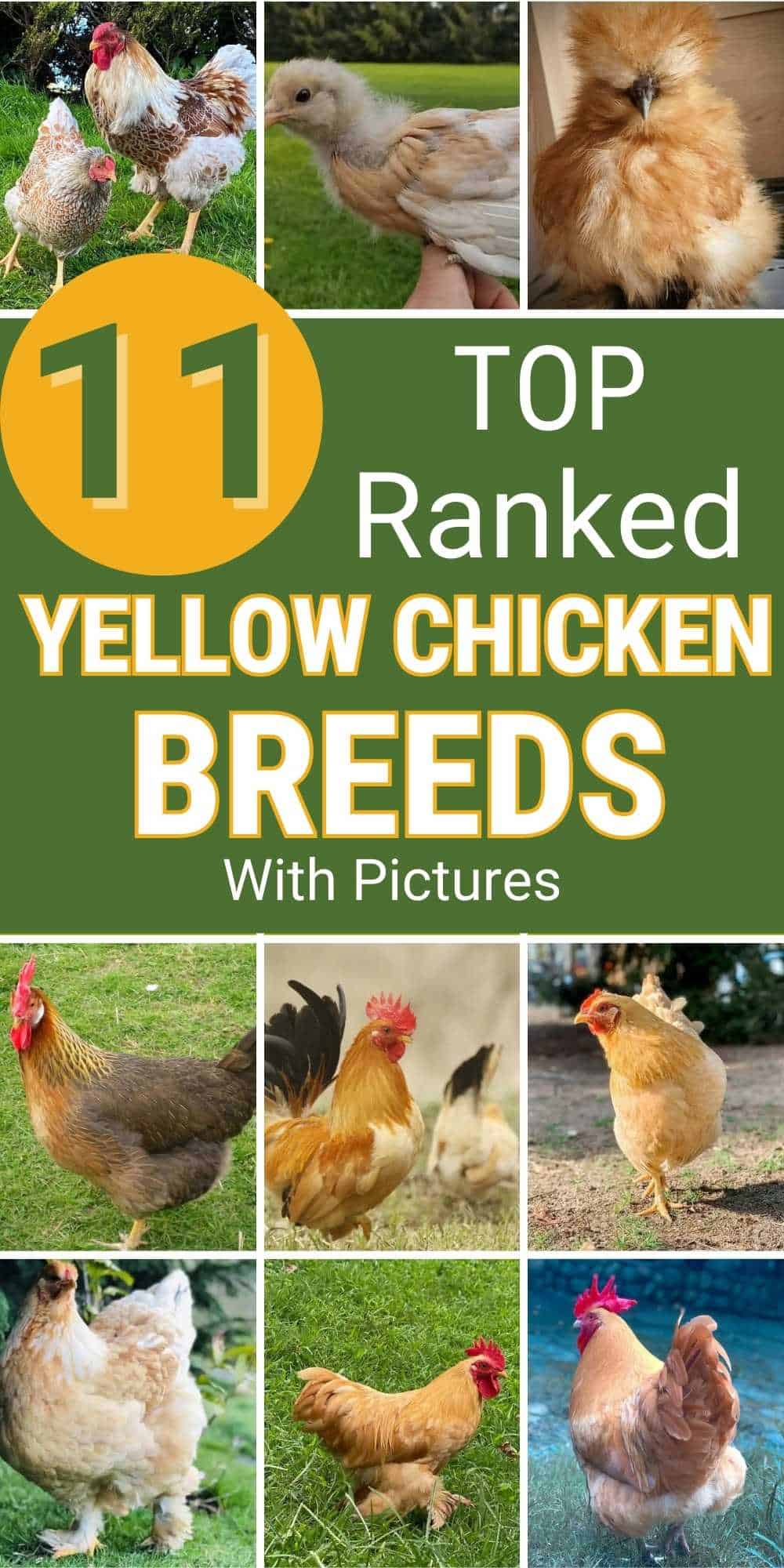

Joseph Hudson has been raising chickens for over 15 years. In 2018, he completed the Agriculture & Natural Resources program at Mt. San Antonio College. He currently raises over 1400 chickens on his 7.5-hectare farm. He keeps sharing his experience on raising healthy and happy chickens on Chicken Scratch The Foundry.








Didn’t help me much with the bread